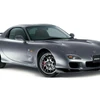Flying car racing is now a thing

- Electric flying car races will take place this year
- Lightweight machines will reach speeds of around 200 km/h
- Machines to be remotely controlled on the ground, with a robot ‘aviator’ in the cockpit
The idea of flying cars has long been a dream for many motorists, but the idea has never really made it off the ground, pardon the pun, until now.
Airspeeder, a company based in London, has launched the EXA Series, which will see uncrewed multicopters go ‘blade-to-blade’ in three locations around the world, that would ordinarily be inaccessible to traditional motorsport.
The ‘cars’ are electrically powered vertical take off and landing machines that have a greater thrust-to-weight ratio than an F-15 fighter jet.
Each is remotely controlled by a skilled driver or pilot from a simulator environment that mimics a future cockpit vision. Inside the car is a robot ‘aviator’ that receives the inputs and mimics the movements of the human controller on the ground. The robot will feed back information on cornering and other forces, with the intention of humans taking over the controls inside the cars within the next year.
Tracks won’t be visible in the sky, though they will be digitally governed. Races will be held between 10 and 60 metres in the air.
Each machine will reach speeds of up to 200 km/h, weighs only 130kg and will hit 0-60 mph in 2.3 seconds. Eight motors provide the propulsion, with two blades per motor, positioned where the wheels would usually be on a car. The cars are styled on early Formula One racers of the 1950s, with four arms reaching out to hold the rotor blades.
Races are expected to last 45 minutes each, with each car needing to use three batteries to complete the duration. A single battery will last 15 minutes and can be replaced in a pit stop on the ground lasting just 20 seconds thanks to an innovative ‘slide and lock’ system.
To avoid incidents in the races, a collision avoidance system has been created using a combination of lidar, radar and machine vision.
The first test flights for the Alauda-built machines took place this week in undisclosed test locations in the deserts of South Australia, under the observation of Australia’s Civil Authorisation Safety Authority (CASA).
The successful tests mean that three electric flying car Grands Prix will take place this year.
Pilots are expected to come from aviation, motorsport and eSports backgrounds, with audiences watching via digital streams and not live at the venue.
Up to four teams with two remote pilots per team will compete in the individual events, with the inaugural competition likely to be in the form of a drag race between two ‘works’ teams.
Each entering team will have an identical Mk3 machine, ensuring that pilot skill and team strategy will determine each race result.
“We are proud to make history by introducing the world’s first racing series for flying electric cars,” says Matt Pearson, founder of Airspeeder and Alauda, the constructors of each craft.
“EXA delivers on the promise of a future first shown in science fiction. We are proud to introduce a sport that redefines what humans and machines can achieve together.”
Richard Randle is a motorsport PR professional working with the UK’s top racing circuits and the UK’s premier single-seater category, the BRDC British F3 Championship.


